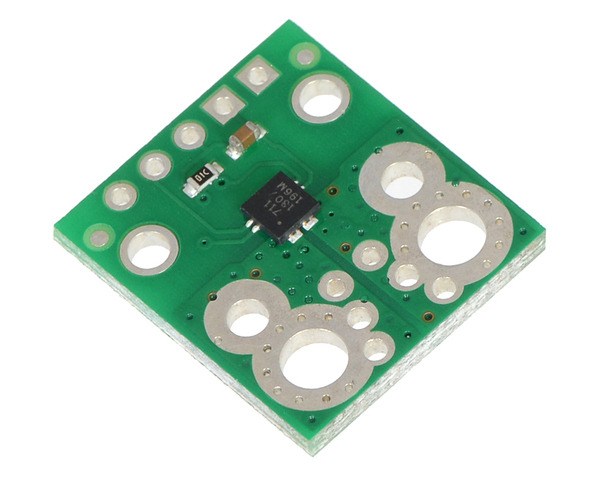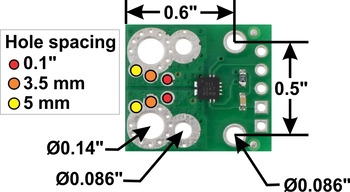Sensors » Current Sensors » ACS711 Current Sensor Carriers »
ACS711KEXLT-15AB-T Current Sensor Carrier -15.5A to +15.5A
This board is a simple carrier of Allegro’s ACS711KEXLT-15AB-T Hall effect-based, electrically isolated current sensor, which offers a low-resistance (~0.6 mΩ) current path and a 100 kHz bandwidth for fast response times.
| Part Suffix | Range | Sensitivity @ 3.3 V | Zero Point @ 3.3 V | Fault Trip Level | Supply Voltage |
|---|---|---|---|---|---|
| KEXLT-15AB-T | ±15.5 A (bidirectional) | 90 mV/A | 1.65 V | ±15.5 A | 3 V to 5.5 V |
Alternatives available with variations in these parameter(s): current range Select variant…
| Description | Specs (10) | Pictures (6) | Resources (5) | FAQs (0) | On the blog (0) | Distributors (52) |
|---|
 |
 |
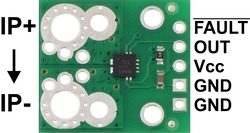 |
Overview
We are offering these breakout boards with support from Allegro Microsystems as an easy way to use or evaluate their ACS711 Hall effect-based, electrically isolated current sensors with overcurrent fault output; we therefore recommend careful reading of the ACS711 datasheet before using this product. This sensor has an operating voltage of 3 V to 5.5 V and an output sensitivity of 90 mV/A when Vcc is 3.3 V (or 136 mV/A when Vcc is 5 V). The following list details some of the sensor’s key features:
- Hall effect-based sensor with electrically isolated current path allows the sensor to be inserted anywhere along the current path and to be used in applications that require electrical isolation.
- Designed for bidirectional input current from -15.5 A to 15.5 A (though the robust sensor IC can tolerate 100 ms transient current spikes up to 100 A).
- Conductive path internal resistance is typically 0.6 mΩ, and the PCB is made with 2-oz copper, so very little power is lost in the board.
- 100 kHz bandwidth analog output voltage proportional to AC or DC currents.
- Good accuracy and reliability: factory calibration results in a typical total output error of ±5% at room temperature, the output offset voltage is extremely stable, and the sensor has zero magnetic hysteresis.
- Overcurrent FAULT output latches low when current magnitude exceeds 15.5 A.
- Operating temperature range of -40°C to 125°C.
- 0.7″×0.8″ carrier board offers a variety of ways to insert it into the current path and 0.1″-pitch (breadboard compatible) power, ground, and output pins.
The pads are labeled on the bottom silkscreen, as shown in the picture to the right. The silkscreen also shows the direction that is interpreted as positive current flow via the +i arrow.
This 15.5 A current sensor is marked with a black X. We also sell a 31 A version that uses the same carrier PCB; you can distinguish the versions by reading the text on the IC or by looking at the color of the X on the bottom silkscreen.
Using the sensor
Electrical connections
The sensor requires a supply voltage of 3 V to 5.5 V to be connected across the Vcc and GND pads, which are labeled on the bottom silkscreen. The sensor outputs an analog voltage that is linearly proportional to the input current. The quiescent output voltage is Vcc/2 and changes by 90 mV per amp of input current (when Vcc = 3.3 V), with positive current increasing the output voltage and negative current decreasing the output voltage. The relationship between the instantaneous input current, i, and sensor output voltage, VOUT, can be represented by the following equations:
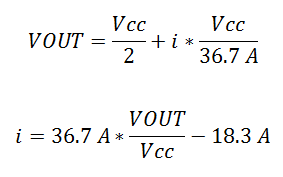 |
The FAULT pin is normally high and latches low when the current exceeds ±15.5 A. Once the FAULT pin is latched low, the only way to reset it is by toggling power on the Vcc pin. In our tests, this module was able to handle 15 A of continuous current without exceeding 50°C, with no cooling beyond the heat dissipation of the PCB.
|
|
The input current can be connected to the board in a variety of ways. Holes with 0.1″, 3.5 mm, and 5 mm spacing are available as shown in the diagram above for connecting male header pins or terminal blocks. For high-current applications, you can solder wires directly to the through-holes that best match your wires, or you can use solderless ring terminal connectors, as shown in the picture above. The large through-holes are big enough for #6 screws.
Warning: This product is intended for use below 30 V. Working with higher voltages can be extremely dangerous and should only be attempted by qualified individuals with appropriate equipment and experience.
Mounting information
The board has two mounting holes on the logic side of the board. These mounting holes are 0.5″ apart and are designed for #2 screws.
Included components
This board ships assembled with all surface mount components, and a 5×1 strip of 0.1″ header pins is included but not soldered in, as shown in the picture below.
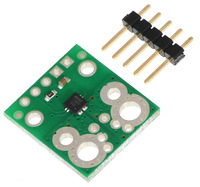 |
ACS711EX current sensor carrier with included 5 × 1 0.1″ header pins. |
|---|
Schematic and dimension diagrams
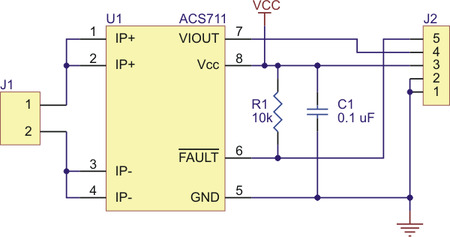 |
ACS711 current sensor carrier schematic diagram. |
|---|
The dimension diagram is available as a downloadable PDF (273k pdf).
Comparison of the Pololu current sensor carriers
We have a variety of current sensors available with different ranges, sensitivities, and features. You can use the following table to compare our options:
 |
 |
 |
 |
 |
 |
 |
 |
 |
 |
 |
|
|---|---|---|---|---|---|---|---|---|---|---|---|
| ACS711 Current Sensor Carriers |
ACS71240 Current Sensor Carriers |
ACS724 Current Sensor Carriers |
ACS37220 Current Sensor Compact Carriers |
ACS37220 Current Sensor Large Carriers |
ACS37030 Current Sensor Compact Carriers |
ACS37030 Current Sensor Large Carriers |
ACS72981 Current Sensor Compact Carriers |
ACS72981 Current Sensor Large Carriers |
CT432/CT433 TMR Current Sensor Compact Carriers |
CT432/CT433 TMR Current Sensor Large Carriers |
|
| Allegro Sensor | ACS711KEXT | ACS71240 | ACS724LLCTR | ACS37220 | ACS37030 | ACS72981xLR | CT432/CT433 | ||||
| Sensing technology | Hall effect | Hall effect | Hall effect | Hall effect | Hall effect + inductive coil | Hall effect | XtremeSense™ TMR (tunneling magnetoresistance) |
||||
| Logic voltage range | 3.0–5.5 V | 3.3V ver: 3.0–3.6 V 5V ver: 4.5–5.5 V |
4.5–5.5 V | 3.3V versions: 3.15–3.45 V 5V versions: 4.5–5.5 V |
3.0–3.6 V | 3.3V versions: 3.0–3.6 V 5V versions: 4.5–5.5 V |
3.3V versions: 3.0–3.6 V 5V versions: 4.75–5.5 V |
||||
| Family current range | 15.5–31 A | 10–50 A | 2.5–50 A | 100–200 A | 20–65 A | 50–200 A | 20–70 A | ||||
| Current range/ sensitivity of individual versions |
Bidirectional:(1) ±15.5 A / 90 mV/A ±31 A / 45 mV/A |
3.3V Bidirectional: ±10 A / 132 mV/A ±30 A / 44 mV/A ±50 A / 26.4 mV/A 5V Bidirectional: ±10 A / 200 mV/A ±30 A / 66 mV/A ±50 A / 40 mV/A 5V Unidirectional: 0–50 A / 80 mv/A |
5V Bidirectional:(2) ±2.5 A / 800 mV/A ±5 A / 400 mV/A ±10 A / 200 mV/A ±20 A / 100 mV/A ±30 A / 66 mV/A ±50 A / 40 mV/A 5V Unidirectional:(2) 0–5 A / 800 mv/A 0–10 A / 400 mv/A 0–20 A / 200 mv/A 0–30 A / 133 mV/A |
3.3V Bidirectional: ±100 A / 13.2 mV/A ±150 A / 8.8 mV/A 5V Bidirectional: ±100 A / 20 mV/A ±150 A / 13.3 mV/A ±200 A / 10 mV/A |
3.3V Bidirectional: ±100 A / 13.2 mV/A ±150 A / 8.8 mV/A 5V Bidirectional: ±100 A / 20 mV/A ±150 A / 13.3 mV/A ±200 A / 10 mV/A |
3.3V Bidirectional: ±20 A / 66 mV/A ±65 A / 20.3 mV/A |
3.3V Bidirectional: ±65 A / 20.3 mV/A |
3.3V Bidirectional:(1) ±50 A / 26.4 mV/A ±100 A / 13.2 mV/A ±150 A / 8.8 mV/A ±200 A / 6.6 mV/A 3.3V Unidirectional:(1) 0–50 A / 52.8 mv/A 0–100 A / 26.4 mv/A 0–150 A / 17.6 mv/A 0–200 A / 13.2 mv/A 5V Bidirectional:(2) ±50 A / 40 mV/A ±100 A / 20 mV/A ±150 A / 13.3 mV/A ±200 A / 10 mV/A 5V Unidirectional:(2) 0–100 A / 40 mv/A 0–150 A / 26.7 mv/A |
3.3V Bidirectional:(1) ±50 A / 26.4 mV/A ±100 A / 13.2 mV/A ±150 A / 8.8 mV/A ±200 A / 6.6 mV/A 3.3V Unidirectional:(1) 0–50 A / 52.8 mv/A 0–100 A / 26.4 mv/A 0–150 A / 17.6 mv/A 0–200 A / 13.2 mv/A 5V Bidirectional:(2) ±50 A / 40 mV/A ±100 A / 20 mV/A ±150 A / 13.3 mV/A ±200 A / 10 mV/A 5V Unidirectional:(2) 0–100 A / 40 mv/A 0–150 A / 26.7 mv/A |
3.3V Bidirectional: ±20 A / 50 mV/A ±30 A / 33.3 mV/A ±50 A / 20 mV/A ±70 A / 14.3 mV/A 3.3V Unidirectional: 0–20 A / 100 mv/A 0–30 A / 66.7 mv/A 0–50 A / 40 mv/A 0–65 A / 30.8 mv/A 5V Bidirectional: ±20 A / 100 mV/A ±30 A / 66.7 mV/A ±50 A / 40 mV/A ±65 A / 30.8 mV/A 5V Unidirectional: 0–20 A / 200 mv/A 0–30 A / 133.3 mv/A 0–50 A / 80 mv/A 0–70 A / 57.1 mv/A |
3.3V Bidirectional: ±50 A / 20 mV/A ±70 A / 14.3 mV/A 3.3V Unidirectional: 0–50 A / 40 mv/A 0–65 A / 30.8 mv/A 5V Bidirectional: ±50 A / 40 mV/A ±65 A / 30.8 mV/A 5V Unidirectional: 0–50 A / 80 mv/A 0–70 A / 57.1 mv/A |
| IC current path resistance | 0.6 mΩ | 0.6 mΩ | 0.6 mΩ | 0.1 mΩ | 0.7 mΩ | 0.2 mΩ | 1 mΩ | ||||
| PCB | 2 layers, 2-oz copper |
2 layers, 2-oz copper |
2 layers, 2- or 4-oz copper(4) |
2 layers, 2-oz copper |
6 layers, 2-oz copper |
2 layers, 2-oz copper |
6 layers, 2-oz copper |
6 layers, 2-oz copper |
6 layers, 2-oz copper |
2 or 4 layers(5), 2-oz copper |
6 layers, 2-oz copper |
| Max bandwidth | 100 kHz | 120 kHz | 120 kHz(3) | 150 kHz | 5 MHz | 250 kHz | 1 MHz | ||||
| Size | 0.7″ × 0.8″ | 0.7″ × 0.8″ | 0.7″ × 0.8″ | 0.7″ × 0.8″ | 1.4″ × 1.2″ | 0.7″ × 0.8″ | 1.4″ × 1.2″ | 0.7″ × 0.8″ | 1.4″ × 1.2″ | 0.8″ × 1.1″ | 1.4″ × 1.2″ |
| Overcurrent fault output |
User-configurable threshold | ||||||||||
| Common-mode field rejection | |||||||||||
| Nonratiometric output | |||||||||||
| 1-piece price | $3.49 | $3.95 | $6.95 – $7.49 | $4.95 | $7.95 | $7.95 | $10.95 | $9.95 | $12.95 | $8.95 | $12.95 |
(1) Sensitivity when Vcc = 3.3 V; actual sensitivity is ratiometric (i.e. it is proportional to Vcc).
(2) Sensitivity when Vcc = 5 V; actual sensitivity is ratiometric (i.e. it is proportional to Vcc).
(3) Bandwidth can be reduced by adding a filter capacitor.
(4) 50A version uses 4-oz copper PCB; all other versions use 2-oz copper.
(5) 50A and higher versions use a 4-layer PCB; all other versions use a 2-layer PCB.
You can also use the following selection box to see all these options sorted by current range:
Alternatives available with variations in these parameter(s): current range Select variant…
People often buy this product together with:
 |
ACS711KEXLT-31AB-T Current Sensor Carrier -31A to +31A |
